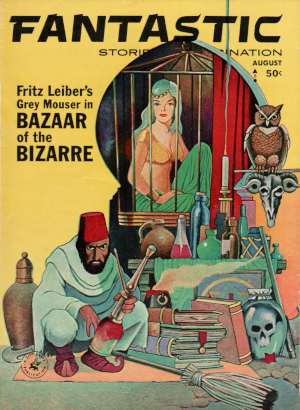 Leiber at Troynovant:
Leiber at Troynovant:
spectral stagecraft of Fritz Leiber (1910-1992);
by, about, discussed, or quoted,
listed by Type and Title
A monster is a symbol of the secret and powerful, the dangerous and unknown, arousing dread and curiosity, exaltation and frightened laughter. An old geographer looks at the large blank spaces of his finished map and inks in "Here Be Monsters." Perhaps his imagination is stirred and he draws a little picture of ... something. ...
A symbol of this sort has a thousand meanings and more. So a monster, symbolizing that about which we can only speculate and wonder, is a master symbol suggesting the remotest mysteries of nature and human nature, the most dimly-sensed secrets of space, time, and the hidden regions of the mind. ...
This vivid picture [in H. P.Lovecraft's "The Outsider"] of the confrontation of the conforming crowd by the "inner-directed" deviant points up one of the chief trends in fantasy writing during the last three decades: the compulsion to understand the monster.
This trend is one of the marks of the transition from the contrast between the extraterrestrial beings of Lovecraft and those of, say, Weinbaum or Heinlein or Smith, with the monsters of van Vogt somewhere in between. You can even say that one writer sets a problem by creating a monster. Then another writer may attempt to solve the problem by explaining the monster, sometimes by speculations about the physics and chemistry of alien planets and sometimes by showing us what the first writer has or may have projected into his creation from himself and the world. This process is crucial in the growth pattern and life history of monsters in the realm of art.
One of the clearest indications that the monster symbolizes the deviant individual is the frequency with which he appears in the guise of scapegoat ...
"Monsters and Monster Lovers"
Speech at Pacificon II / Westercon 17:
22nd World Science Fiction Convention
Oakland, 5 September 1964video —
YouTubetranscripts —
Fritz Leiber
The Book of Fritz Leiber (1974)Fritz Leiber
Fafhrd & Me (1990)
|
— works by Leiber, reviewed — |
||
| Bread Overhead | Fritz Leiber | RW Franson |
| Bullet With His Name | Fritz Leiber | RW Franson |
| Dreams of Albert Moreland, The | Fritz Leiber | RW Franson |
| Green Millennium, The | Fritz Leiber | RW Franson |
| Ill Met in Lankhmar | Fritz Leiber | RW Franson |
| Improper Authorities, The | Fritz Leiber | RW Franson |
| Last Letter, The | Fritz Leiber | RW Franson |
| Night Passage | Fritz Leiber | RW Franson |
| Sadness of the Executioner, The | Fritz Leiber | RW Franson |
| Snow Women, The | Fritz Leiber | RW Franson |
| Space-Time for Springers | Fritz Leiber | WH Stoddard |
| Thieves' House | Fritz Leiber | RW Franson |
| To Arkham and the Stars | Fritz Leiber | RW Franson |
| Trapped in the Sea of Stars | Fritz Leiber | RW Franson |
|
— essays; and works about Leiber, reviewed — |
||
| Fafhrd and the Gray Mouser series Fritz Leiber |
RW Franson | |
|
— discussion or mention of Leiber — |
||
| Confined Choices Door, Corridor, & Maze Stories |
RW Franson | |
| Demigoddess of the Mind James H. Schmitz's heroine Telzey Amberdon | RW Franson | |
| Game of Rat and Dragon, The | Cordwainer Smith | RW Franson |
| In Search of Wonder: Essays on Modern Science Fiction |
Damon Knight | RW Franson |
| Lose the Loose Road-Bumps of Word-Substitution via Misspelling |
RW Franson | |
| Poker Face | Theodore Sturgeon | RW Franson |
| Science Fiction Ideas & Dreams The Illustrated Book of |
David Kyle | RW Franson |
| To Say Nothing of the Dog | Connie Willis | RW Franson |
|
— Leiber, quoted — |
||
| Charles Fort Prophet of the Unexplained |
Damon Knight | RW Franson |
[Enter GOWER, before the monument of MARINA at Tarsus]
Gower:Thus time we waste, and long leagues make short,
Sail seas in cockles, have and wish but for't,
Making to take our imagination,
From bourn to bourn, region to region.
By you being pardoned, we commit no crime
To use one language in each several clime
Where our scene seems to live. I do beseech you
To learn of me who stand i'th' gaps to teach you,
The stages of our story.William Shakespeare
Pericles, Prince of Tyre, 4.4.1-9
Lankhmar
The Fritz Leiber Home Page
magazine cover, top right:
Fantastic August 1963
by Vernon Kramer
Personae at Troynovant
an alternate Contents
via emanant Olympians
| Troynovant, or Renewing Troy: | New | Contents | |
| recurrent inspiration | Recent Updates | |
|
www.Troynovant.com |
||
|
Reviews Essays by Title:
A-B
C-F
G-L
M-R
S-Z
If you do not see the Troynovant banner at the top, |
||
| Personae | Strata | Topography |
|
|